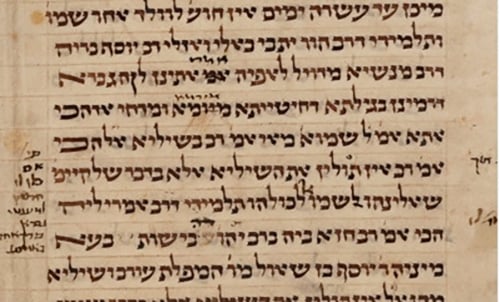
Sanhedrin 57a discusses the Seven Noachide Laws. While most of the Torah and Talmud discuss laws pertaining to Jews, there are certain basic moral assumptions that apply to all of humanity. On this daf, a specific group of second-generation Babylonian Amoraim — “Rav Huna, Rav Yehuda, and all of Rav’s students”—assert that not only is murder a capital offense, but all the Noachide laws are as well. Other Amoraim, such as third-generation Rav Sheshet and Rav Yosef, argue that only a subset of three or four of these laws are capital offenses.
What do we know about this specific group? Well, we know Rav Huna as the eventual head of the Sura academy and Rav Yehuda as eventual head of the Pumbedita academy. We know that both Rav Huna and Rav Yehuda were first-generation Rav’s students. I don’t think that this is an enumeration of separate entities whose position happened to coincide and so are listed together. Rather, we are talking about a group in a very defined era.
In Berachot 42b, Amoraim argue about whether a blessing made over wine brought out in the middle of a meal exempts the wine brought out after a meal from a blessing. Rav says it exempts; his colleague / student Rav Kahana I says it does not. Then, in the second and third scholastic generation, Rav Nachman (Nehardea academy) while Rav Sheshet (Shilhe academy) does not. Finally, “Rav Huna, Rav Yehuda, and all of Rav’s students” say that it doesn’t exempt, taking a position contrary to Rav!
Regardless of this dispute, we see this same grouping of rabbis listed here. I would guess that these students constituted Rav’s academy in the years immediately following Rav’s death. They are not directly interacting with Rav, and Rav Huna and Rav Yehuda, both students of Rav, are together with the rest of the academy.
In Niddah 26b, Shmuel was sitting with Rav’s students. The Vilna printed text also lists Rav Yehuda sitting there, but earlier Soncino and Venice printings and manuscripts don’t list him yet. As Rav Yosef b. Rav Menashya of Dvil approached, Shmuel said to Rav’s students, “A man approaches who can be knocked down with a straw of wheat and then cannot get up,” implying that he could be easily refuted. When he arrived, Shmuel asked him what Rav’s position was regarding the ritual impurity of an afterbirth. He replied with Rav’s position, which Shmuel had not heard. Thereupon, Shmuel asked all of Rav’s students and they confirmed this position. Shmuel then looked at Rav Yehuda harshly. This was because Rav Yehuda had previously been Rav’s student, and had come to study from Shmuel after Rav’s death. He should have informed Shmuel of Rav’s position. This story may illustrate how this grouping of Rav’s students appear, together with Rav Yehuda, in the period after Rav’s death.
There are specific students who are singled out as talmidei deRav. In Pesachim 103b and Chullin 86b, Rav Beruna and Rav Chananel, second-generation students of Rav, sat at a meal, with Rav Yeiva the Elder (also perhaps a student of Rav) as their waiter. They asked for a cup of wine to recite bentching, then changed their minds and wanted him to give them a cup of wine to drink. He informed them that Rav said that once they uttered the first, they were prohibited from drinking more within the meal. Perhaps this, too, occurred after Rav’s passing.
The same Rav Beruna and Rav Chananel, students of Rav, were present at the incident in Naresh, where a woman had been betrothed when still a minor (Yevamot 110a); when she came of age, she went under the chuppah with her husband-to-be, but another man in Naresh preempted and married her. These students of Rav didn’t require a bill of divorce from the latter man, and this is taken as having bearing on Rav’s position.
In Berachot 47a, Rav’s students are also described as having a meal. Rav Acha approaches, and they want to give him the honor of reciting the blessing, though he tells them that the main participant in the meal must bless. These may be other students. In Pesachim 105b, Rav Chananya bar Shelemya and other students of Rav sat at a meal, with Rav Hamnuna the Elder as their waiter. The meal perhaps extended into Shabbat. They wanted to find out if Shabbat had arrived, such that they should pause the meal, but Rav Hamnuna told them this was unnecessary.
Finally, in Berachot 42b, we find that when Rav died, his students followed his casket. When they returned, they said, “Let’s eat bread on the banks of the Dannak River.” After they ate, they wrestled with this dilemma: The Mishna said that reclining together makes a joint meal for a mezuman. What about merely sitting? And, even without that, does deciding beforehand to eat jointly at a place (the riverbank) transform it into the level of reclining? They couldn’t figure it out. Then, Rav Adda bar Ahava I, Rav’s student, stood, reversed his cloak, and ripped it again in mourning, saying, “Rav is dead, and we haven’t learned the halachot of bentching.” This was so until an Elder came, raised a contradiction between the aforementioned Mishna and a brayta, and resolved it such that designating a place to meet and eat made it like reclining.
Thus there is a recurring theme of Rav’s students participating in meals and unsure of what to do, until an Elder (Rav Yeiva, Rav Hamnuna, this unnamed Elder) comes and establishes what Rav said or what the halacha is. While these students probably are not all the same as Rav Beruna and Rav Chananel, it still makes sense that these students feel unmoored in the years after Rav’s death, and before Rav Huna’s formal appointment as head of Sura.
Rabbi Dr. Joshua Waxman teaches computer science at Stern College for Women, and his research includes programmatically finding scholars and scholastic relationships in the Babylonian Talmud.









